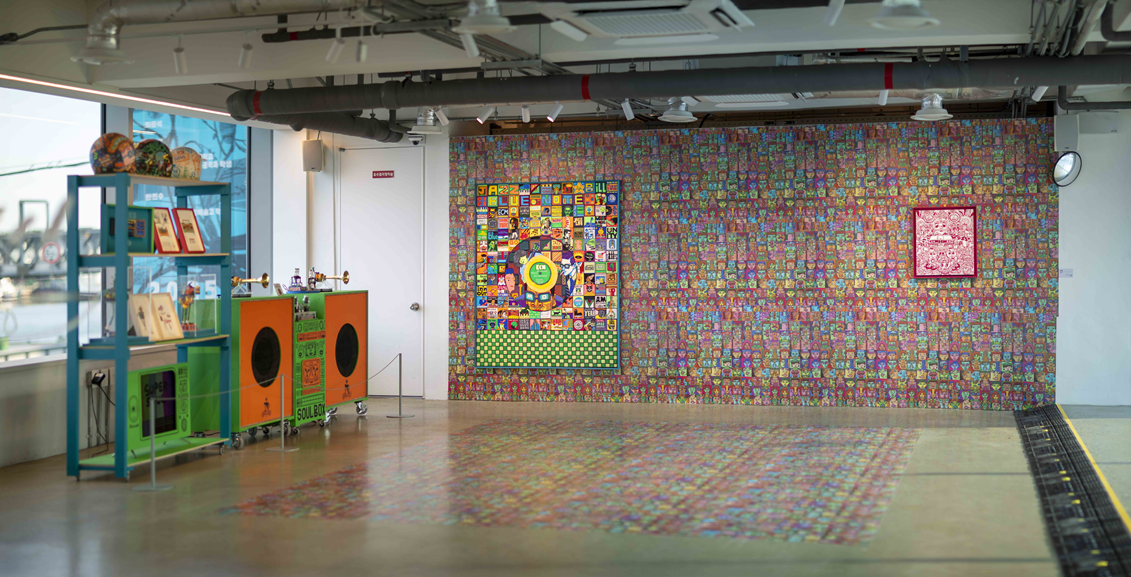

뮤직룸 : MUSIC ROOM
“전자 신호와 자석의 움직임으로 공기를 울려 음악을 재생하는 숨쉬는 기계이자 오디오 설치 작품으로, 새로운 감각적 경험을 제시한다.”
김태중 뮤직룸은 700 × 500 × 500cm 규모의 혼합 재료 설치 작품으로, 2025년에 완성되었다. 이 작품은 전자 신호가 자석의 움직임을 통해 진동을 만들어내고, 그 진동이 공기를 움직여 음악을 재생하는 방식으로 작동한다. 작가는 이를 “숨쉬는 기계”라 부르며, 음악을 물리적 공명과 결합하여 예술적 경험으로 확장시킨다.
단순한 오디오 장치를 넘어, 김태중 뮤직룸은 예술과 기술의 경계에서 관객에게 새로운 청각적·시각적 풍경을 제안한다. 작품은 작가가 직접 제작한 스피커와 앰프를 통해 음악을 구현하며, 동시대 예술이 소리를 어떻게 공간 속에 재배치하고 확장할 수 있는지를 보여준다.
숨쉬는 기계와 음악의 만남
이 작품의 핵심은 “숨쉬는 기계” 개념이다. 기계는 단순히 무생물적 도구가 아니라, 살아 움직이며 호흡하는 유기체처럼 기능한다. 김태중 뮤직룸에서 소리는 단순한 음파가 아니라, 기계적 움직임과 전자적 신호가 결합한 물질적 현상으로 드러난다. 이는 음악이 귀로만 듣는 경험이 아니라, 공간 전체를 진동시키는 체험임을 강조한다.
관객은 작품 속에서 단순한 청취자가 아니라, 음악적 파동과 기계적 호흡을 함께 느끼는 참여자가 된다. 소리의 떨림이 공기를 흔들고, 그 공기가 몸을 울리며, 음악은 물리적 실재로 다가온다.
오디오 장치와 드로잉머신
김태중 뮤직룸은 작가가 직접 제작한 스피커와 앰프를 통해 음악을 구현한다. 이는 상업적 오디오 기기를 단순히 차용한 것이 아니라, 작가적 실험으로 재탄생한 오브제다. 또한 작가는 “드로잉머신”이라는 숨쉬는 기계를 통해 다양한 작업을 병행해왔다. 기계는 선을 그리고, 리듬을 기록하며, 음악과 시각예술 사이를 잇는 매개체로 작동한다.
관람자는 작품을 통해 음악과 드로잉, 기계적 움직임과 인간 감각이 서로 얽히는 새로운 예술적 차원을 경험하게 된다.
관객 경험과 감각의 확장
이 작품의 중요한 지점은 관객 경험이다. 김태중 뮤직룸은 단순히 음악을 듣는 것이 아니라, 음악이 어떻게 공간을 점유하고, 몸을 울리고, 감각을 확장하는지를 체험하게 한다. 관객은 음악이 “숨쉬는 기계”를 통해 재생되는 순간, 소리의 물리적 진동을 감각적으로 경험한다.
이 경험은 청각적 차원을 넘어 시각과 촉각을 자극하며, 음악과 설치미술 사이의 경계를 허문다. 관객은 작품 속에서 일상의 오디오 경험을 넘어선 예술적 호흡을 만나게 된다.
동시대 예술 속 위치
김태중 뮤직룸은 동시대 예술에서 기술과 감각의 관계를 탐구하는 흐름 속에 자리한다. 이 작품은 소리를 단순한 청각적 사건으로 환원하지 않고, 기계적 움직임과 공간적 진동을 통해 확장된 경험으로 제시한다. 이는 뉴미디어 아트, 사운드 아트, 설치미술이 만나는 접점에서 중요한 의의를 가진다.
작가는 “숨쉬는 기계”라는 개념을 통해 기술을 단순한 도구가 아닌 예술적 생명체로 제시하며, 예술이 인간 감각을 새롭게 조직하는 방식을 탐구한다.
예술과 기술의 공명
궁극적으로 김태중 뮤직룸은 음악과 기계, 기술과 감각이 서로 공명하는 예술적 장치다. 작품은 단순히 소리를 재생하는 오디오가 아니라, 숨쉬는 기계와 함께 음악을 호흡하는 공간적 경험을 창출한다. 관객은 그 속에서 자유롭게 감각을 확장하고, 음악과 예술이 만들어내는 새로운 차원의 울림을 만난다.
“A breathing machine and an audio installation that reproduces music by vibrating air through the movement of magnets driven by electronic signals, offering a new sensory experience.”
Kim Taejung’s Music Room (2025) is a large-scale mixed media installation measuring 700 × 500 × 500 cm. The work operates by transforming electronic signals into the movement of magnets, generating vibrations that displace air and produce sound. The artist refers to this as a “breathing machine”—an audio system that extends music into an embodied artistic experience through physical resonance.
Beyond the function of an ordinary audio device, Music Room situates itself at the threshold of art and technology, offering audiences a novel auditory and visual landscape. Through speakers and amplifiers handcrafted by the artist, the work demonstrates how contemporary art can reconfigure and expand the placement of sound within space.
The Breathing Machine and Sound
At the heart of the installation lies the concept of the “breathing machine.” The machine is not conceived as an inanimate tool but as a living organism that moves and breathes. In Music Room, sound emerges not merely as acoustic waves but as a material phenomenon, produced by the convergence of mechanical motion and electronic signal. This underscores that music is not only an aural experience but also a spatial vibration that envelops the entire environment.
In this context, the viewer is no longer a passive listener but an active participant who senses both musical waves and mechanical respiration. The tremor of sound shakes the air, that air reverberates through the body, and music manifests as physical presence.
Audio Devices and the Drawing Machine
Music Room employs speakers and amplifiers personally crafted by the artist. These are not borrowed from commercial audio systems but reimagined as experimental objects. The artist has also developed a series of works using a “drawing machine,” another form of breathing machine, which generates lines, records rhythms, and serves as a mediator between music and visual art.
Through these devices, the audience encounters a new artistic dimension where music, drawing, mechanical motion, and human perception interlace.
Audience Experience and Expanded Sensation
A crucial dimension of Music Room is the experience of the spectator. The work is not about merely listening to music; it allows the audience to experience how sound occupies space, resonates through the body, and extends sensory awareness. When the “breathing machine” activates, the viewer perceives the physical vibration of sound as a tactile and spatial phenomenon.
This experience transcends auditory perception, stimulating both vision and touch while dismantling the boundary between music and installation art. Within the work, spectators encounter a mode of artistic respiration that surpasses the everyday experience of audio.
Position within Contemporary Art
Music Room positions itself within contemporary explorations of the relationship between technology and the senses. It does not reduce sound to a purely auditory event but presents it as an expanded phenomenon shaped by mechanical motion and spatial vibration. In doing so, the work situates itself at the intersection of new media art, sound art, and installation.
Through the notion of the “breathing machine,” Kim Taejung reframes technology as an artistic organism rather than a neutral tool, probing the ways in which art reorganizes human perception.
Resonance of Art and Technology
Ultimately, Kim Taejung’s Music Room is an artistic apparatus in which music, machine, technology, and sensation resonate together. It is not merely an audio system that reproduces sound, but a spatial experience in which music is breathed through a mechanical organism. Within this encounter, the audience expands their own sensorial boundaries and discovers new dimensions of resonance produced by the union of sound and art.


